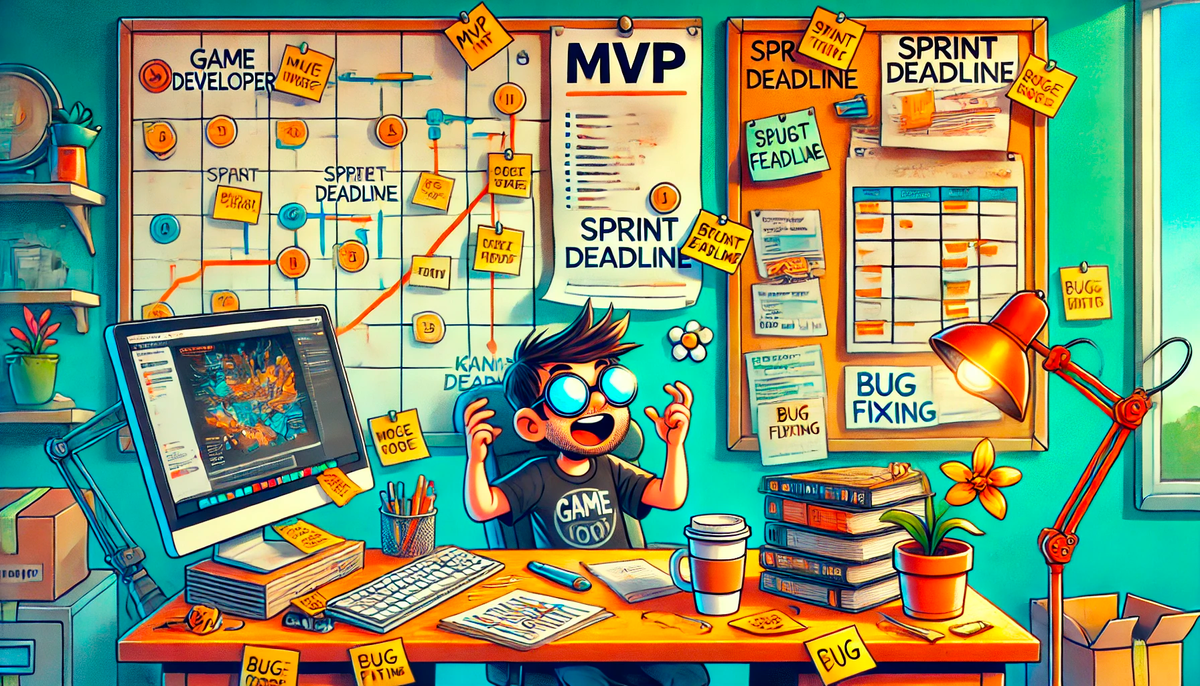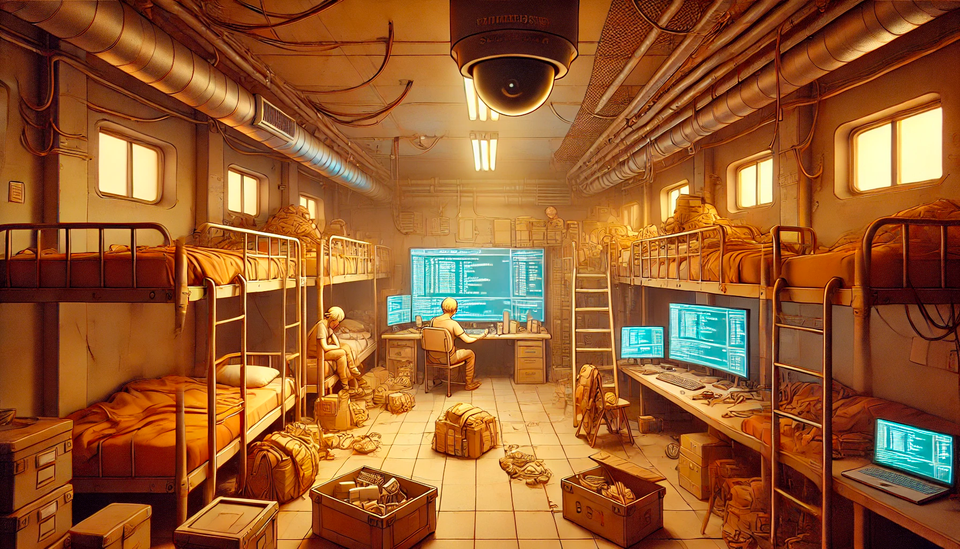Organizing Your Game Development Project - From Roadmap to MVP

Introduction
Developing a game solo is like planning an expedition to Antarctica with just a backpack and a plastic compass, if you don’t at least have a rough plan, you’ll end up wandering in the blizzard forever. The goal of this article? To hand you a map, a few landmarks, and some advice to help you avoid the storm of procrastination and the avalanche of overwork.
1. Structuring Your Development with a Roadmap
Think of your project as a quest in an RPG. You have a main objective (“release the game”) and a ton of side quests (“fine-tune the animation of coffee machines”). Without a roadmap, you’ll end up lost in the wild, tackling everything and nothing at the same time.
A roadmap is like your quest log: it breaks your goal into achievable steps and keeps you moving forward without losing sight of the big picture. More importantly, it forces you to set deadlines. Without dates, a task becomes an academic research project spanning multiple generations.
Example of a realistic roadmap:
- Month 1: Core gameplay loop
- Month 2: UI and interaction mechanics
- Month 3: Testing and balancing a playable version
The key is to define checkpoints that let you measure progress, rather than getting lost perfecting the pixel art on a random chair texture.
2. Focusing on an MVP to Move Forward Efficiently
An MVP (Minimum Viable Product) is like ordering a pizza with just dough and tomato sauce, it’s not the feast of the century, but it lets you check if the foundation is solid before adding twelve toppings that might make you regret everything.
The idea is to create a playable but minimal version of your game to test the core mechanics before getting sucked into an endless feature creep (also known as the art of turning a simple game into a full-blown intergalactic civilization simulator).
A good MVP includes:
- A functional gameplay loop (the player should be able to do something, not just admire placeholder assets)
- Key mechanics that can be tested (if it’s a management game, the management should actually work!)
- A usable interface (it doesn’t have to be pretty, just understandable)
What can wait:
- Ultra-realistic ray tracing mode
- 150 side quests with 600 lines of dialogue
- An orchestral soundtrack performed by a full symphony
Building an MVP ensures that your game is actually fun before you invest three years and 50,000 lines of code into it.
3. Finding a Balance Between Discipline and Flexibility
Ah, organization. Either you schedule your work down to the minute, or you rely on inspiration to code until 4 AM while blasting synthwave. Both approaches have the same issue: without balance, you’re heading for burnout.
Avoiding Overwork
Working on your game is great. Sleeping, eating, and having a social life are also highly recommended. Plan your work sessions so you don’t burn through all your energy in the first month.
Avoiding Procrastination
Not overworking doesn’t mean doing nothing. Set short, achievable deadlines to avoid tasks dragging on for weeks.
Regularly Reevaluating
You thought your prototype would be done in two weeks, but you’re still debugging a health bar that refuses to display? That’s normal. Adjust your goals regularly to keep a pace that matches reality.
4. Tracking Progress with a Project Management Tool
Managing a project without a tracking tool is like assembling IKEA furniture without instructions. It might work, but you’ll probably end up with extra pieces and something that wobbles.
Project management in game development often revolves around two main philosophies: Kanban and Scrum. Kanban is like an upgraded to-do list: you categorize tasks as "To Do," "In Progress," and "Done" on a board (Trello is great for this). Scrum, on the other hand, is based on "sprints", short development cycles where you define specific goals (typically two weeks long).
Why Use Scrum Even When Working Solo?
Scrum isn’t just for big teams. When working solo, it helps structure your workflow and avoid stagnation. A two-week sprint forces you to prioritize and deliver tangible progress rather than getting lost in minor details.
My Personal Approach
I use Jira and Scrum to organize my project. Each sprint lasts two weeks, with tasks broken down into smaller objectives. At the end of the sprint, I do a quick retrospective to assess what was accomplished and what needs adjusting. This keeps my progress steady without feeling overwhelmed.
If you tend to get distracted, a Trello board with clear deadlines can help keep you on track. Jira is a powerful alternative, but better suited for more complex projects.
Ultimately, the goal isn’t to spend more time planning than coding, it’s to avoid sinking into chaos.
5. Taking Time to Review and Refactor at the End of a Sprint
At the end of each sprint, it’s crucial to take a step back and analyze what’s been built. Code written under pressure can often contain redundancies, fragile structures, or implementations that will cause headaches in the future.
The idea is simple: identify what needs refactoring. If it’s a small fix, handle it immediately. If it’s a larger issue, add it to the backlog.
What is the Backlog?
The backlog is a prioritized list of tasks to be tackled in the future. It helps manage and organize improvements that aren’t urgent but are necessary in the long run. Adding necessary refactors to the backlog ensures you keep your codebase clean while maintaining sprint focus.
Doing this reflection at the end of each sprint helps anticipate future incompatibilities and prevents accumulating an unmanageable technical debt.
Conclusion
Developing a game is a marathon, not a sprint (except in Scrum, ironically). If you want to reach the finish line, stay organized, set achievable goals, and most importantly, enjoy the journey.
Now tell me, what’s your secret to staying motivated? Share your tips in the comments!
Introduction
Développer un jeu vidéo en solo, c'est comme organiser une expédition en Antarctique avec un sac à dos et une boussole en plastique : si tu ne prépares pas un minimum ton itinéraire, tu risques d'errer dans le blizzard jusqu'à la fin des temps. L’objectif de cet article ? Te filer une carte du territoire, quelques points de repère et des conseils pour éviter la tempête de la procrastination et l'avalanche du surmenage.
1. Structurer son développement avec une roadmap
Imagine que ton projet soit une quête dans un RPG. Tu as une mission principale (« sortir un jeu ») et plein de quêtes secondaires (« peaufiner l’animation des cafetières »). Sans roadmap, tu vas vite finir par errer dans la pampa en t'attaquant à tout et n'importe quoi.
Une roadmap, c'est comme ton journal de quête : elle découpe ton objectif en étapes atteignables et te permet d'avancer sans perdre le cap. Mais surtout, elle te force à fixer des deadlines. Sans date, une tâche devient un projet de recherche sur plusieurs générations.
Exemple de roadmap réaliste :
- Mois 1 : Boucle de gameplay de base
- Mois 2 : UI et gestion des interactions
- Mois 3 : Test et équilibrage de la version jouable
L'important, c'est de définir des checkpoints qui te permettent de vérifier que tu avances et non que tu perfectionnes l’art du pixel parfait sur une texture de chaise.
2. Se concentrer sur un MVP pour avancer efficacement
Un MVP (Minimum Viable Product), c’est comme commander une pizza avec juste la pâte et la sauce tomate : ce n'est pas encore le festin du siècle, mais ça te permet de voir si la recette de base fonctionne avant de rajouter 12 ingrédients qui te feront regretter ta vie.
L'idée, c'est de créer une version jouable mais minimaliste de ton jeu, pour tester les mécaniques de base avant de sombrer dans l'ajout incontrôlé de features (qu'on appelle le feature creep, ou l’art de transformer un simple jeu en simulateur de civilisation intergalactique).
Un bon MVP contient :
- Une boucle de gameplay fonctionnelle (le joueur doit pouvoir jouer, pas juste admirer des placeholders)
- Des mécaniques clés testables (si ton jeu est basé sur la gestion, il faut que la gestion fonctionne !)
- Une interface utilisable (pas forcément jolie, mais compréhensible)
Ce qui peut attendre :
- Le mode ultra-réaliste en ray tracing
- Les 150 quêtes secondaires et leurs 600 lignes de dialogues
- L'OST composée par un orchestre symphonique
Faire un MVP, c'est s'assurer que ton jeu est intéressant avant d'y investir trois ans et 50 000 lignes de code.
3. Trouver un équilibre entre discipline et flexibilité
Ah, l'organisation. Soit tu es du genre à planifier tes journées à la minute près, soit tu comptes sur ton inspiration du moment pour coder jusqu'à 4h du mat' en écoutant du synthwave. Dans les deux cas, le problème est le même : sans équilibre, tu vas te planter.
Éviter la surcharge de travail
Travailler sur ton jeu, c’est bien. Dormir, manger et avoir une vie sociale, c’est pas mal non plus. Planifie tes sessions de travail de manière à ne pas brûler tout ton carburant en un mois.
Éviter la procrastination
Ne pas se surmener, ça ne veut pas dire ne rien faire. Fixe-toi des deadlines courtes et atteignables pour éviter de laisser traîner des tâches pendant des semaines.
Réévaluer régulièrement
Tu pensais finir ton prototype en deux semaines et t’es encore en train de débugger une barre de vie qui refuse de s'afficher ? C'est normal. Ajuste tes objectifs régulièrement pour garder un rythme adapté à la réalité.
4. Suivre son avancement avec un outil de gestion de projet
Gérer un projet sans outil de suivi, c'est comme essayer de monter un meuble IKEA sans notice. Ça peut fonctionner, mais tu risques de finir avec un truc bancal et des pièces en trop.
La gestion de projet informatique repose en partie sur deux grandes philosophies : Kanban et Scrum. Kanban, c’est le post-it amélioré : tu classes tes tâches dans "À faire", "En cours" et "Fait" sur un tableau (Trello fait ça très bien). Scrum, en revanche, repose sur des "sprints" de développement, où tu fixes des objectifs précis sur des périodes courtes (typiquement deux semaines).
Pourquoi Scrum est utile même en solo ?
Scrum n’est pas réservé aux grandes équipes. Quand tu travailles seul, il t’aide à structurer ton rythme de travail et à éviter les périodes de stagnation. Un sprint de deux semaines te force à définir des priorités et à livrer des avancées concrètes, plutôt que de perdre du temps sur des détails insignifiants.
Mon approche personnelle
J’utilise Jira et Scrum pour organiser mon projet. Chaque sprint dure deux semaines, avec des tâches découpées en sous-objectifs. En fin de sprint, je fais une rétrospective rapide pour voir ce qui a été accompli et ce qui doit être ajusté. Ce processus me permet de maintenir un bon rythme sans me sentir dépassé.
Si tu as tendance à t’éparpiller, un tableau Trello avec des deadlines précises peut vraiment t’aider à garder le cap. Jira est une alternative puissante, mais plus adaptée aux projets complexes.
Bref, le but n'est pas de passer plus de temps à organiser qu'à coder, mais bien d'éviter de sombrer dans le chaos.
5. Prendre du recul en fin de sprint : l'importance du refactoring
À la fin de chaque sprint, il est essentiel de lever la tête du guidon et d’analyser ce qui a été produit. Le code écrit sous pression peut contenir des redondances, des structures fragiles ou des implémentations qui risquent de poser problème plus tard.
L'idée est simple : identifier les éléments à refactoriser. Si c'est une petite amélioration, autant la corriger immédiatement. Si cela demande plus de temps, on l’ajoute au backlog.
Qu'est-ce que le backlog ?
Le backlog est une liste de tâches à faire dans le futur. Il sert à prioriser et organiser les améliorations qui ne sont pas urgentes mais qui sont nécessaires à terme. Ajouter les refactorisations nécessaires dans le backlog permet de s’assurer que l’on garde une base de code propre tout en évitant d’interrompre le sprint en cours.
Faire ce travail de réflexion en fin de sprint permet d’anticiper les incompatibilités futures et d’éviter d’accumuler une dette technique ingérable.
Conclusion
Développer un jeu, c'est un marathon, pas un sprint (à part dans Scrum, mais bon). Si tu veux aller au bout, organise-toi, fixe-toi des objectifs atteignables et surtout, amuse-toi en chemin.
Maintenant, dis-moi : c'est quoi ta technique pour rester motivé ? Partage tes astuces en commentaire !

